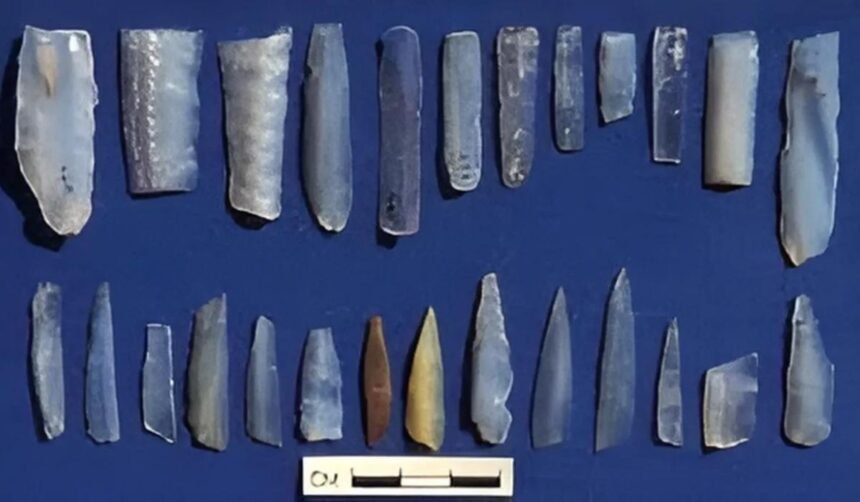Blades have been an integral part of human history, serving as essential tools for survival, warfare, and ritualistic purposes. While today’s world is dominated by steel and composite materials, the history of stone blades is a testament to early human ingenuity and craftsmanship. The use of blades of stone marks a significant milestone in the evolution of tool-making, with their durability and versatility enabling early civilizations to thrive in challenging environments. This article explores the fascinating world of blades of stone, diving into their history, creation process, cultural significance, and modern-day fascination.
1. The Origins of Blades of Stone
Long before the discovery of metals, early humans depended on stone tools for survival. Some of the earliest known blades of stone date back to the Paleolithic era, where sharpened stones were used for cutting, hunting, and protection. These early stone blades were rudimentary, often made by chipping away at larger rocks to create a sharp edge.
The primary materials used for creating these early stone blades were flint, obsidian, and quartzite. These stones were chosen for their hardness and ability to be shaped into sharp, precise edges. The technique of flint knapping, for instance, was pivotal in crafting blades of stone that were efficient and reliable.
2. The Craftsmanship Behind Blades of Stone
Crafting blades of stone requires a great deal of skill and precision. Ancient artisans used a method called percussion flaking to shape the stone, striking it with a hammerstone to remove small, controlled pieces. This process was meticulous and could take hours or even days to perfect, depending on the size and purpose of the blade.
Some of the most famous stone blades come from the Neolithic era, where the refinement of the blade-making process reached new heights. Obsidian, a volcanic glass, was particularly favored for its sharpness, often sharper than steel. These blades of stone were used not only for hunting and cutting but also in ceremonial practices, as they symbolized power and craftsmanship.
3. Cultural Significance of Blades of Stone
In many ancient cultures, blades of stone held significant cultural and spiritual value. For example, in Mesoamerican civilizations like the Aztecs and Mayans, obsidian blades were considered sacred. They were used in sacrificial rituals and were believed to hold mystical powers. The sharpness and darkness of obsidian made it a fitting material for rituals that required precision and reverence.
In other parts of the world, such as Africa and the Pacific Islands, blades of stone were used in rites of passage and as status symbols. Chiefs and warriors often carried elaborately crafted stone blades, which signified their rank and prowess in battle. The use of these blades in religious and ceremonial contexts highlights their deep-rooted significance beyond mere utility.
4. Blades of Stone in Warfare
While blades of stone are most commonly associated with early human survival and hunting, they also played a critical role in ancient warfare. Before the widespread use of metal weapons, armies would equip themselves with stone blades, which were effective in close combat. The sharpness of obsidian, for example, allowed for clean cuts, making it a deadly weapon on the battlefield.
The Maori of New Zealand famously used stone weapons in their wars, with finely carved greenstone blades (pounamu) being highly prized. These blades of stone were not only functional but also considered sacred, often passed down through generations as heirlooms.
5. The Decline of Blades of Stone and the Rise of Metal
As metallurgy advanced, blades of stone gradually became obsolete. The advent of bronze and later iron led to the creation of more durable and efficient weapons. However, stone blades continued to be used in regions where metalworking had not yet spread or in cultures that revered stone tools for spiritual reasons.
Despite the rise of metal tools, blades of stone never completely disappeared. They remained in use for specific tasks where their sharpness was unmatched, such as in rituals or for certain types of surgical procedures, particularly with obsidian, which is still used in modern surgeries today due to its superior sharpness compared to steel.
6. Modern Fascination with Blades of Stone
In modern times, blades of stone have experienced a resurgence in interest among collectors, historians, and survival enthusiasts. Primitive skills gatherings, where participants learn ancient crafting techniques, often feature workshops on creating stone blades. These gatherings help preserve the knowledge of ancient tool-making and highlight the enduring appeal of blades of stone.
Reenactors and archaeologists also recreate stone blades to better understand the tools and techniques of our ancestors. By studying these ancient weapons, we gain insights into the daily lives, struggles, and triumphs of early humans.
7. Blades of Stone in Popular Culture
The mystique surrounding blades of stone has not been lost in popular culture. From movies to video games, these ancient tools are often portrayed as relics of a bygone era, imbued with magical or spiritual powers. For instance, obsidian blades have been featured in fantasy novels and films, often as weapons of great power or as tools used in sacred rituals.
This portrayal of blades of stone as more than mere tools reflects our enduring fascination with the past and the technological innovations that helped shape human civilization.
8. Practical Uses of Blades of Stone Today
Though they may seem archaic, blades of stone are still used in some practical applications today. Obsidian scalpels, for example, are used in certain types of surgeries because of their fine, sharp edge. These scalpels are incredibly precise, making them ideal for delicate operations.
In the field of archaeology, blades of stone are often replicated to help researchers understand how ancient people lived and worked. By studying the wear patterns on these recreated tools, archaeologists can infer how they were used and what tasks they were suited for, such as butchering animals, carving wood, or processing plant materials.
9. The Environmental Benefits of Blades of Stone
In a world increasingly concerned with sustainability and environmental impact, blades of stone offer a glimpse into how early humans used natural resources with minimal environmental footprint. The production of stone blades requires no smelting, refining, or heavy industrial processes, making it a far more eco-friendly option compared to metal blades.
Though the world has moved on to more advanced materials, the simplicity and low environmental impact of crafting blades of stone remain a point of interest for those looking for sustainable alternatives.
10. The Legacy of Blades of Stone
The legacy of blades of stone is undeniable. These simple yet effective tools allowed early humans to hunt, defend themselves, and perform daily tasks with greater efficiency. They played a crucial role in the survival and development of human societies, enabling early civilizations to thrive.
Though blades of stone may no longer be a common tool in our daily lives, their influence can still be felt in modern technology, craftsmanship, and culture. From the surgical precision of obsidian scalpels to the artistic recreation of ancient weapons, stone blades continue to inspire and educate.
Conclusion
Blades of stone have carved their place in history as one of the earliest and most important human inventions. From their humble beginnings as survival tools to their role in shaping civilizations, these blades have left a lasting impact on human society. Whether in the hands of ancient warriors, skilled artisans, or modern-day enthusiasts, blades of stone remain a symbol of human ingenuity, craftsmanship, and resilience.
As we continue to explore our past and learn from it, the legacy of blades of stone serves as a reminder of our ancestors’ resourcefulness and adaptability, offering valuable lessons for the present and future.










